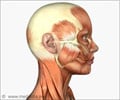A small molecule blocks an aberrant pathway associated with myotonic dystrophy type 1, the most common form of muscular dystrophy, has been designed by researchers at the University of Illinois.
A small molecule blocks an aberrant pathway associated with myotonic dystrophy type 1, the most common form of muscular dystrophy, has been designed by researchers at the University of Illinois.
The new compound, soon to be tested in cells, binds tightly to its target, an abnormally elongated RNA that hijacks part of the normal cellular machinery and brings on symptoms of the disease. The newly developed compound is the first to show high selectivity in binding the target while not disrupting other important RNA functions. The study appears this week in the Proceedings of the National Academy of Sciences.Myotonic dystrophy type 1, a muscle degeneration disease that so far is untreatable, affects about one in 8,000 people worldwide. Some cases are mild, but others lead to a debilitating loss of muscle control, declines in organ function and other potentially life-threatening conditions.
Scientists have recently identified a primary causative agent of the disease, a mutant version of a gene, called DMPK, which contains an excessive number of tri-nucleotide repeats. Nucleotides are the chemical letters that spell out the sequence of a gene, and the normal version of the DMPK gene includes five to 34 cytosine-thymine-guanine (CTG) repeats. The mutant version of the gene includes 50 to as many as 10,000 CTG repeats.
"The longer the repeat the worse the disease and the earlier the onset of the disease," said U. of I. chemistry professor and department head Steven Zimmerman, who co-led the research with his colleague, chemistry professor Anne Baranger.
When the mutant DMPK is transcribed into RNA, the first step toward building a protein, these (now CUG) repeats bind to a cellular protein, MBNL, which normally splices other RNA transcripts. The bound MBNL cannot function properly, causing a cascade of negative effects in the cell. Improperly spliced RNAs lead to improperly formed proteins.
Preventing the MBNL protein from binding to the CUG repeats has been shown to ease the symptoms of the disease.
Advertisement
The CUG repeats in the aberrant RNA are an ideal target for drug development because they are not found in any other known RNA molecule, Baranger said.
Advertisement
In the course of basic research into compounds that bind to DNA or RNA, the researchers designed a molecule that would selectively bind to T-T or U-U mismatches in DNA or RNA, respectively. (Mismatches occur when two nucleotides in a double-stranded molecule are improperly paired, as occurs in the CTG repeats in the mutant DNA and the CUG repeats in the RNA.) Their compound, which they call Ligand 1, binds to the region of excessive repeats in both the RNA and DNA from the aberrant DMPK gene. More importantly, Ligand 1 prevents the MBNL protein from binding to the RNA.
Further tests revealed that the new compound has significantly lower affinity for other mismatches in DNA or RNA. Baranger's lab also tested the compound on other normal protein-RNA complexes, and found that it did not disrupt those interactions.
This last finding was critical, Zimmerman said.
"The danger is if you make something that binds to RNA or DNA, it's going to bind to all these other molecules and disrupt those complexes, so you help one problem but you cause all these others. Our molecule doesn't do that."
Source-Eurekalert
RAS









